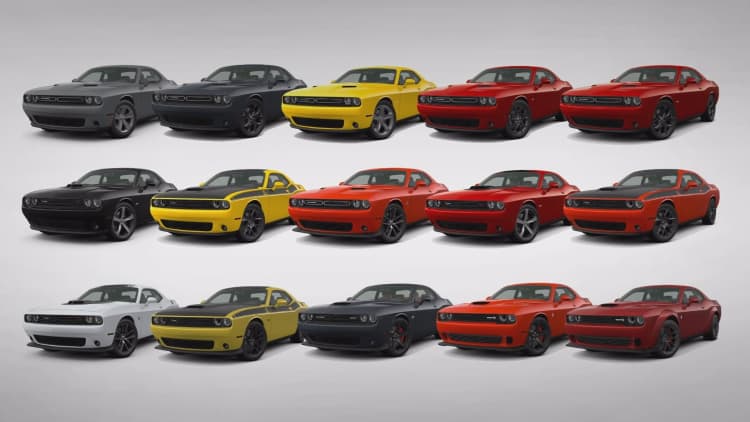
Dodge has two car models, the Challenger and the Charger, but sells nine different versions of the Charger and a whopping 16 different versions of the Challenger.
Sedans and other traditional passenger cars are losing their grip on American consumer appetites, but automakers are still finding ways to make money on at least some of them, by doing more with less.
Offering different trims, or sharing parts and platforms is nothing new, but the pace at which companies are developing new packages has increased over the last decade or so, said IHS Markit analyst Stephanie Brinley.
Advancements in engineering and computing power give automakers a greater range of different features they can package in different ways, such as a variety of engines and powertrains, drive mode settings, cabin features and others things.
"The amount of computing power you have today is phenomenal," Brinley told CNBC. That has opened up a lot of new opportunities for engineering teams and allows them to turn out new products a lot faster.
"It does feel like the pace has quickened," she said.
The segments catering to enthusiasts, such as sports cars and "muscle cars," tend to have the most success with this strategy.
"These are high-image vehicles sold to people who are enthusiastic and passionate about what they drive, and they like to feel the car they have is special," she said.
And the cars often are special, with changes to the vehicle's engineering that suit it better to certain driving situations.
Ford recently added another trim to its Mustang GT, which itself is already a step up from the base model Mustang.
The Performance Pack Level 2 is a $6,500 package that gives the GT some extra features, like wider wheels and street-legal tires that can also perform well on a track.
The option will cater to a small demographic. Ford is selling it only in North America and it will be available only on manual transmission Mustangs.
It follows the first-level GT Performance Package, which is about half the price and has some of the features in the Level 2. Bumping up the chain a bit there is the Shelby GT350, which starts at $57,240, about $30,000 more than the base model.
It's the same for the Dodge. The Challenger, for example, starts at about $27,000. But halfway up the long chain of trim levels, the Challenger R/T Scat Pack has 485 horsepower compared with the base model's 305, and costs about $39,000.
At the top, there is the Dodge Hellcat Widebody which starts at $71,495.
There are also six different trims available for the Chevrolet Camaro — from the base model, which starts at around $26,000 to the supercharged ZL1, which will cost above $60,000.
And it is also about meeting customer demand, Brinley said, as many enthusiasts who buy these vehicles want a lot of these features. There is already a pretty large business in aftermarket parts for these vehicles and shops that perform custom work.
But it is also convenient for automakers.
Sports cars tend to see more sales at the beginning of their typically five- to six-year life cycle, and then they taper off, so this a way of keeping that momentum going, Brinley said.
These higher trims and special editions can give automakers higher profit margins — though the companies won't say what the margins on any of these vehicles are.
It also lets the manufacturers display engineering prowess and it provides a halo that feeds the image of the overall brand.
Meanwhile, the companies get a lot of variety out of a single platform, while sharing parts, which allows them to better achieve economies of scale, said Kelley Blue Book analyst Rebecca Lindland.
"You have this broad market, it may not be very deep, but it is very broad," Lindland said.
For example, Ford sells base model Mustangs to rental fleets and Dodge can sell Chargers to police departments, and then each can sell different versions of the same car to racing enthusiasts.
"These types of vehicles can take on a lot of different personalities," she said. "You have these extreme examples of use. But they can do all that for short money, because the investment is in the R&D and the tooling."


